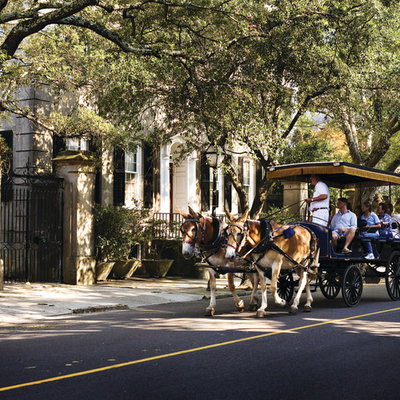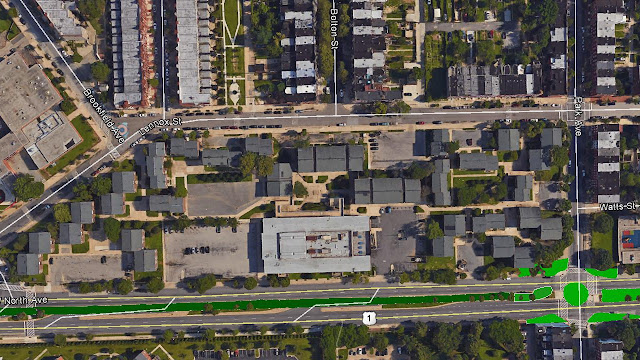Sports are traditionally an important way to transcend the black-white racial divide, but at Pimlico racetrack, the city needs to take a big step beyond that. The Preakness race is great, but that's only once a year, beyond which "race" has other highly charged meanings. Pimlico needs a full-time solution - a neighborhood that lets us step out of ourselves.
 |
| Could the Pimlico racetrack neighborhood look like this? (Horse-drawn rides are always popular.) |
The city that revolutionized baseball at Camden Yards now needs an even more radical change involving the way people see horse racing at Pimlico. Historic Pimlico racetrack is already Camden Yards, Fenway Park and Wrigley Field rolled up in one. Now it's a matter of recreating a feeling that transcends history, that elevates us inside and outside the racetrack.
The geography of change
Pimlico's surrounding geography can fully cooperate. Much has been made of the contrast between white affluent Mount Washington neighborhood to the north and black lower income Park Heights to the south. But physically, the racetrack itself creates an east-west split, not a north-south split. Both the east and west sides of the track include sections of both Mount Washington and Park Heights, but the east side also includes the Levindale neighborhood just to the south, which is one of the most stable attractive sections of Park Heights, along with the large Lifebridge Health complex of the Sinai and Levindale Hospitals.
Distinctive and attractive genuine stone houses on Laurel Avenue in the Levindale section of Park Heights,
two blocks south of the racetrack property.
|
Oriole Park at Camden Yards taught much about this in the 1990s. The adjacent Ridgely's Delight and Otterbein neighborhoods see Camden Yards as a unique asset. Parking can be taken care of with residential permits, although for an annual event as huge as the Preakness, the neighborhoods participate fully as resident hosts, embracing rather than shunning their outside guests. Parking can be managed. It is absurd for economic development "experts" to use parking as a primary criterion for urban vs. suburban racetrack comparisons.
And building luxury suites? They're soooo 1980s. Yeah sure, if some rich guys want to shut out the crowd and encapsulate their entourages in private cocoons without participating in the action and interaction, that's fine. They even provide big screen TVs, as if recreating the feeling of a club basement "man cave" is the goal. But luxury suites have nothing to do with the overall experience at Pimlico, Laurel racetrack or anyplace else - not even at allegedly "state of the art" Churchill Downs or Jerry Jones' Dallas football palace. They're an irrelevant oxymoron that's just hanging on like "Reality TV".
The time is over when suburban places like Laurel are seen as the solution to urban problems. So when will we learn? Back when horses rather than cars were dominant in cities, pollution was just the mundane stuff on the street you accidentally stepped in. And a "stable neighborhood" referred to the horse houses behind where the wealthy lived.
But now in ironic postmodern times, it may be possible to create a lucrative niche real estate market where the romantic equestrian clippety-clop is a common sight and sound in front of your house. Such things have already happened in rural communities. So as often happens, cities are the final frontier. And where better to do it than as a backdrop to the Home of the Preakness, second jewel of thoroughbred racing's triple crown?
 |
| Here's what a horse neighborhood could look like. Imagine this as a Pimlico backdrop. |
South Mount Washington: Putting the horse before the cart (or car)
So here's the concept: Create a new kind of neighborhood just east of the racetrack that would be physically integrated with both Mount Washington to the north and Park Heights to the south, but with a totally unique environment.
While much is made of black vs. white, here horses would be #1 and humans would be #2, regardless of breed. Everything would be optimized for horses, so all the issues of animal rights activists would be addressed. The mundane ramshackle horse stables that currently flank the racetrack periphery would be replaced with stables of suitable grandeur. Horse-people would then live above them, just as they did in the 19th century.
Street surfaces would be horse friendly. Traffic speeds would be governed by the horses, just as they are by the culture in Amish country.
This could be a "gated community" for the purposes of keeping the horses inside, rather than with any of the usual exclusionary connotations. Well designed entrance gates would also actually become an attraction of their own, since they would be the focal point at which the neighborhood reaches out to its surroundings. Additional suitable security measures to protect valuable thoroughbreds would also be implemented. (In horse culture, it's not yet politically incorrect to say "well-bred".)
Pimlico Road should be reopened in some form to provide the greatest integration with the racetrack and the surrounding communities. A strong neighborhood interface with the Lifebridge Health complex should also be created, including common use of its attractive densely wooded green spaces, which should be expanded by replacing some of its parking lots with structured parking. A bucolic "bridle path" through this area, eastward to Cylburn Park, would also be a great addition.
The name of this new equestrian neighborhood should be decided by the real estate experts, but "South Mount Washington" might be appropriate because it already lends cachet and value (cache?cash, eh?) as the identity of one of the city's most rustically attractive neighborhoods. (No offense, Park Heights, you benefit as well.)
The area's new 21st century amenities, geared to larger crowds of jobs and visitors with more general purposes, would be focused on the area west of the racetrack, north of the intersection of Park Heights and Belvedere Avenues.
 |
Horses from the Pimlico horse neighborhood could serve as ambassadors to the surrounding neighborhoods.
This may also create a viable and acceptable way to resurrect the "A-Rab" produce carts.
|
It would spread some of that Preakness feeling over the other 364 days a year, although people probably wouldn't wear those crazy Preakness fashions every day. By celebrating horses, both at Pimlico and its surroundings, we would all get beyond ourselves to celebrate, strengthen and revitalize life as a whole.




